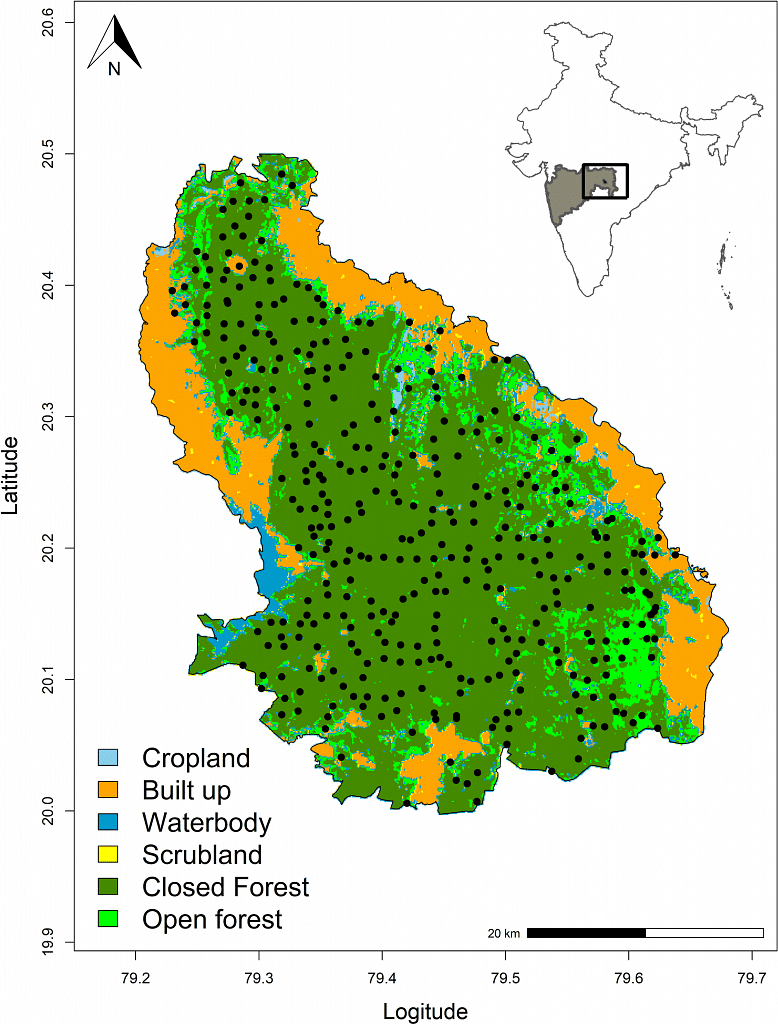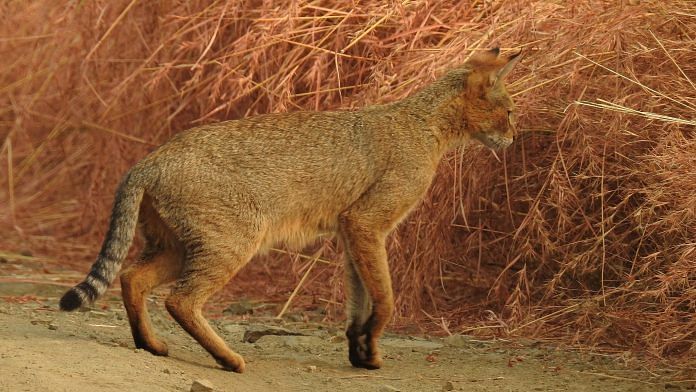Studies on small cats remain limited with carnivore research in India being skewed towards large cats. Small cats are more specialized than their larger cousins in terms of resource selection. Studies on small cat population and habitat preference are critical to evaluate their status to ensure better management and conservation. We estimated abundance of two widespread small cats, the jungle cat, and the rusty-spotted cat, and investigated their habitat associations based on camera trap captures from a central Indian tiger reserve. We predicted fine-scale habitat segregation between these sympatric species as a driver of coexistence.
Forest cover and evapotranspiration were positively associated with rusty-spotted cat occurrence whereas both factors had a significant negative relation with jungle cat occurrence. The results directed habitat segregation between these small cats with affinities of rusty-spotted cat and jungle cat towards well-forested and open scrubland areas respectively. Our estimates highlight the widespread applicability of this model for density estimation of species with no individual identification. Moreover, the study outcomes can aid in targeted management decisions and serve as the baseline for species conservation as these models allow robust population estimation of elusive species along with predicting their habitat preferences.
What we studied
Carnivores naturally occur at low densities owing to their apex position in the food web. Concurrently they continue to face rapid population decline caused by contracting range sizes and fragmentation of existing habitat. Asia holds more than 60% of the global diversity of cats, harbouring 21 out of 36 species. India, a mega-biodiverse country, is home to 15 among them. The geographical distribution range of most of these cats lies within protected areas with an average size of less than 400 km2, which contributes to only five percent of the total landmass of the country. Furthermore, these protected areas are located within high densities of human populations dependent on local resources and surrounded by land which is undergoing an upsurge in anthropogenic developmental activities. Given these escalating pressures on felid species in Asia, an in-depth understanding of their population status and habitat use would be fundamental for designing effective conservation and management policies.
Among the small cats native to India, the jungle cat (Felis chaus) and rusty-spotted cat (Prionailurus rubiginosus) are the two, most widespread species. The former belongs to the house cat lineage, whereas the latter to the leopard cat lineage. Rusty-spotted cat, the smallest cat in the world (average body weight 1.6 kg), is also reported to use the arboreal habitat alongside the terrestrial domain. However, no such adaptation has been reported for the jungle cat (average body weight of 5 kg). Both species are known to be nocturnal and elusive. The jungle cat is categorized as “Least Concern” in IUCN red list due to its large distribution range from south-eastern Asia to middle east and eastern Europe, while the rusty-spotted cat was recently downgraded to “Near Threatened” from “Vulnerable”, owing to new records from previously unknown locations.
As both species have overlapping distribution ranges, we aimed at predicting fine-scale segregation in a habitat that enables the coexistence of these sympatric small cats. We hypothesized that habitat segregation at a fine-scale between these two species as a major driver for the cooccurrence. Also, the population estimation would fill the existing knowledge gap of these species using camera-trap captures as our study is the first attempt to estimate the population density of these individually unidentifiable small cats.
Also read: Human exploitation is changing leopard behaviour, with genetic costs
How we studied the cats
We conducted the study in Tadoba-Andhari Tiger Reserve (TATR) in the state of Maharashtra in Central India. The reserve spreads across an area of 1700 km2 in the Deccan plateau. The terrain of TATR is mostly undulating and hilly in the north and flat in the southern part.
We conducted camera-trap surveys in the dry season from February to June 2016. A pair of automated motion-triggered digital camera-traps was deployed at 397 locations without using lure or bait.

In this study individuals of neither species are uniquely identifiable from photographs. Therefore, we used spatial presence-absence (SPA) models. Spatial count models the latent encounters of spatially referenced individuals with sampling devices using data augmentation and Markov chain Monte Carlo (MCMC) sampling in a Bayesian framework.
For each camera site, the detection or non-detection of these cats were recorded on each 24h sampling interval. The state-space (S) was comprised of the sampled area and a surrounding buffer area that is large enough to include all individuals potentially exposed to sampling.
We investigated the habitat associations of the small cats using generalized linear models (GLM). We enumerated total counts at each site considering a 24-hour sampling interval as one sampling occasion and used this as a response variable. Data were pooled from all the four blocks for the analysis. Values of remotely sensed habitat variables; land use/landcover, evapotranspiration, forest-cover, elevation, normalised difference vegetation index (NDVI), distance from village, distance from waterbody were extracted from camera-trap locations with a 100-meter buffer and used as covariates for modelling the species count across sites. We restricted the buffer to 100 meters as we were interested in understanding the habitat preferences of species at a fine scale.
The total survey effort comprised of 10332 trap nights from 397 camera-traps. We photographed 23 mammals during the camera-trap survey including 171 photo-captures of jungle cat and 66 photo-captures of rusty-spotted cat. Of the 397 camera-trap locations, jungle cat was detected at 91 locations and rusty-spotted cat was detected at 38 locations respectively. Both the species were detected together at 9 locations.
Results
We report the first ever population density estimates of jungle cat and rusty-spotted cat that ranges from 3–7 individuals per 100 km2. The estimates, based on the largest camera trapping dataset available for these small cat species, are comparable to density estimates of other small cats. We also observed fine-scale spatial segregation supporting our hypothesis, facilitating co-occurrence between these small cat species.
Although the species have a majorly overlapping distribution range in the Indian subcontinent, at a fine-scale of camera trap sampling sites they hardly cooccur. The factors that significantly affected rusty-spotted cat occurrence were those associated with dense forest while jungle cat occurrence was associated with open forests and scrublands.
Also read: It’ll take more than a safari to ensure endangered species stay protected now
Conclusion
Lack of proper baseline data and ordinated conservation policies have led to local extinction of species from varied habitats globally. Reliable estimates of species abundance and knowledge of their habitat preference are of fundamental importance as they facilitate management goals and policy decisions for successful conservation of species. The understanding of the unique ecological role of small carnivores can be adequately supplemented by baseline data as provided by our study.
The study highlights the importance of different habitat types explaining fine-scale habitat segregation between co-occurring species. With carefully designed field surveys and maintaining proper caution in the generalisation of results, our model may be extended and applied to other species which lack individually identifiable morphological features like pelage patterns (such as civets, bears, and foxes) and are cryptic and elusive besides being of high conservation priority. Trends of population estimates and habitat use from this study can contribute to the assessment of conservation status and devising mitigation principles.
This is an edited excerpt from the paper ‘Population density and habitat use of two sympatric small cats in a central Indian reserve’. Read the full paper here.
Nilanjan Chatterjee is a PhD Student in Wildlife Institute of India. Bilal Habib is a Scientist of Animal Ecology and Conservation biology department of Wildlife Institute of India and principal investigator of the Long Term monitoring project in Vidarbha, Maharashtra. Parag Nigam is a Scientist of Wildlife Health Management of Wildlife Institute of India and the co-PI of the long-term monitoring project.
Views are personal.
Also read: Another pregnant elephant among two ‘poisoned’ to death, this time in Chhattisgarh



